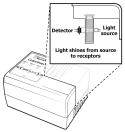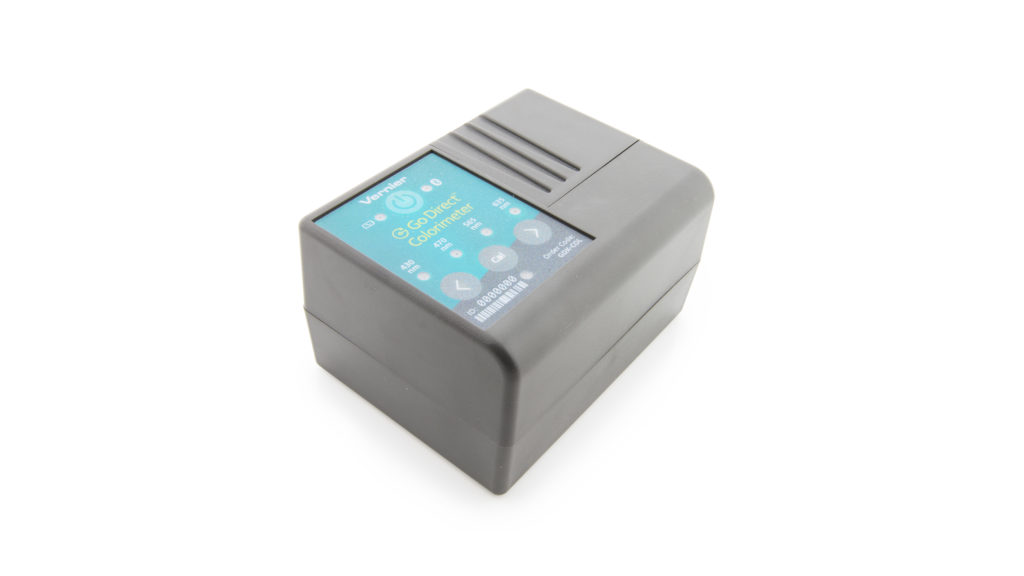Go Direct® Colorimeter User Manual
Order Code: GDX-COL
Go Direct Colorimeter is used to determine the concentration of a solution by analyzing its color intensity. The cuvette slot is designed to accommodate most cuvettes with a 10 millimeter path length. The Colorimeter measures the amount of light transmitted through a sample at a user-selectable wavelength. You may choose from four wavelengths: 430 nm, 470 nm, 565 nm, and 635 nm.
Note: Vernier products are designed for educational use. Our products are not designed nor are they recommended for any industrial, medical, or commercial process such as life support, patient diagnosis, control of a manufacturing process, or industrial testing of any kind.
What's Included
- Go Direct Colorimeter
- 15 polystyrene cuvettes and 15 plastic cuvette lids
- Micro USB Cable
Compatible Software
Choose a platform below to see its compatibility requirements.LabQuest
Interface LabQuest App LabQuest 3 Full support LabQuest 2 Full support 1 LabQuest Incompatible Compatibility Notes
Computers
Software Interface Graphical Analysis Graphical Analysis (Web App) No interface required Full support Full support LabQuest 3 Full support 1 Incompatible LabQuest 2 Full support 1 2 Incompatible Compatibility Notes
Chromebook
Software Interface Graphical Analysis (Web App) No interface required Full support iOS
Software Interface Graphical Analysis Graphical Analysis GW No interface required Full support Full support LabQuest 3 Full support 1 2 Full support 1 2 LabQuest 2 Full support 1 2 3 Full support 1 2 3 Compatibility Notes
Android
Software Interface Graphical Analysis Graphical Analysis GW No interface required Full support Incompatible LabQuest 3 Full support 1 2 Full support 1 LabQuest 2 Full support 1 2 3 Full support 1 3 Compatibility Notes
Python
Software Interface Python No interface required Full support Javascript
Software Interface Javascript No interface required Full support 1 Compatibility Notes
LabVIEW
Software Interface NI LabVIEW No interface required Full support
Quick Start: Vernier Graphical Analysis® and Bluetooth®
- Charge your sensor for at least 2 hours before first use.
- Turn on your sensor. The LED will blink red.
- Launch Graphical Analysis, then click Sensor Data Collection.
- Select your sensor from the list. The sensor ID is located on the sensor label near the bar code. Note: If you don’t see a list of available sensors, click WIRELESS. After selecting your sensor, click Pair.
- Click DONE. You are now ready to collect data.
Using other Vernier data-collection apps or want to connect via USB?
Charging the Sensor
Connect the Go Direct Colorimeter to the included USB Charging Cable and any USB device for two hours.
You can also charge up to eight Go Direct Go Direct Colorimeters using our Go Direct Charge Station, sold separately (order code: GDX-CRG). An LED on each Go Direct Colorimeter indicates charging status.
| Charging |
Orange LED next to the battery icon is solid while the sensor is charging. |
| Fully charged |
Green LED next to the battery icon is solid when the sensor is fully charged. |
Providing Power
| Turning on the sensor |
Press button once. Red LED indicator flashes when unit is on. |
| Putting the sensor in sleep mode |
Press and hold button for more than three seconds to put into sleep mode. Red LED indicator stops flashing when sleeping. |
Connecting the Sensor
See the following link for up-to-date connection information:
Connecting via Bluetooth
| Ready to connect | Red LED next to the Bluetooth icon flashes when sensor is awake and ready to connect. |
| Connected | Green LED next to the Bluetooth icon flashes when sensor is connected via Bluetooth. |
Connecting via USB
| Connected and charging | Orange LED next to the battery icon is solid when the sensor is connected to Graphical Analysis via USB and the unit is charging. LED next to Bluetooth icon is off. |
| Connected, fully charged | Green LED next to the battery icon is solid when the sensor is connected to Graphical Analysis via USB and fully charged. LED next to Bluetooth icon is off. |
| Charging via USB, connected via Bluetooth |
Orange LED next to the battery icon is solid when the sensor is charging. Green LED next to the Bluetooth icon flashes. |
Using the Product
Connect the sensor following the steps in the Getting Started section of this user manual. After connecting the sensor, the following steps must be completed prior to starting data collection.
- Press the < or > button on the Colorimeter to select the correct wavelength for your experiment (430 nm, 470 nm, 565 nm, or 635 nm).
- Allow the Colorimeter to warm up for about five minutes before calibrating.
- Calibrate the Colorimeter.
- Slide the lid of the Colorimeter open to reveal the cuvette slot.
- Insert a cuvette, filled with distilled water or other solvent used to prepare your solutions, for your calibration blank (100% transmittance or 0 absorbance).
Important: Line up one of the clear sides of the cuvette with the arrow at the right side of the cuvette slot. Slide the Colorimeter lid closed. - Press the CAL button on the Colorimeter to begin the calibration process. Release the CAL button when the red LED begins to flash.
- When the red LED stops flashing, the calibration is complete. The absorbance reading should be very close to 0.000 (100%T).
- Remove the blank cuvette from the Colorimeter.
- Continue with data collection.
Calibration
Calibration is required for use. See the Using the Product section for instructions.
Specifications
|
Colorimeter range |
0 to 3 (absorbance) (0 to 100% T) |
|
Useful range |
0.05 to 1.0 absorbance (90% to 10% T) |
|
Wavelengths |
430 nm, 470 nm, 565 nm, 635 nm |
Care and Maintenance
Battery Information
Go Direct Colorimeter contains a small lithium-ion battery. The system is designed to consume very little power and not put heavy demands on the battery. Although the battery is warranted for one year, the expected battery life should be several years. Replacement batteries are available from Vernier (order code: GDX-BAT-300).
Storage and Maintenance
To store Go Direct Colorimeter for extended periods of time, put the device in sleep mode by holding the button down for at least three seconds. The red LED will stop flashing to show that the unit is in sleep mode. Over several months, the battery will discharge but will not be damaged. After such storage, charge the device for a few hours, and the unit will be ready to go.
Exposing the battery to temperatures over 35°C (95°F) will reduce its lifespan. If possible, store the device in an area that is not exposed to temperature extremes.
Water Resistance
Go Direct Colorimeter is not water resistant and should never be immersed in water.
If water gets into the device, immediately power the unit down (press and hold the power button for more than three seconds). Disconnect the sensor and charging cable, and remove the battery. Allow the device to dry thoroughly before attempting to use the device again. Do not attempt to dry using an external heat source.
How the Sensor Works
Light from an LED light source passes through a cuvette containing a solution sample. Some of the incoming light is absorbed by the solution. As a result, light of a lower intensity strikes a photodiode.

Troubleshooting
Here are some tips for best data-collection practices:
- Allow the Colorimeter to warm up for about 5 minutes before calibrating.
- Fill a cuvette two-thirds to three-fourths full with liquid, including the calibration blank, so that the light travels through the liquid reliably.
- After filling a cuvette with liquid, seal the cuvette with a cap to prevent spills.
- Make sure to place a cuvette in the Colorimeter so the path of the light source travels through the clear sides of the cuvette. An arrow to the right of the cuvette slot shows the light path.
- For best results, use one cuvette to make all your measurements for a given experiment.
- If you calibrate a Colorimeter and then change the wavelength, calibrate the Colorimeter again to ensure the proper identification of the new wavelength.
For best results, a sample's absorbance or transmittance values should fall within these ranges:
- percent transmittance:10–90%
- absorbance: 0.05–1.0
Beer’s law experiment results begin to lose their linearity at absorbance values above 1.0 (percent transmittance values less than 10%). If you have a solution that transmits such a low level of light, consider diluting the solution so that it falls within this range.
Repair Information
If you have followed the troubleshooting steps and are still having trouble with your Go Direct Colorimeter, contact Vernier Technical Support at support@vernier.com or call 888-837-6437. Support specialists will work with you to determine if the unit needs to be sent in for repair. At that time, a Return Merchandise Authorization (RMA) number will be issued and instructions will be communicated on how to return the unit for repair.
Accessories/Replacements
| Item | Order Code |
|---|---|
|
CB-USB-MICRO |
|
|
CB-USB-C-MICRO |
|
|
GDX-BAT-300 |
|
| Plastic Cuvettes (Visible Range) |
CUV |
Warranty
Warranty information for this product can be found on the Support tab at www.vernier.com/gdx-col/#support
General warranty information can be found at www.vernier.com/warranty
Contact Support
Fill out our online support form or call us toll-free at 1-888-837-6437.

